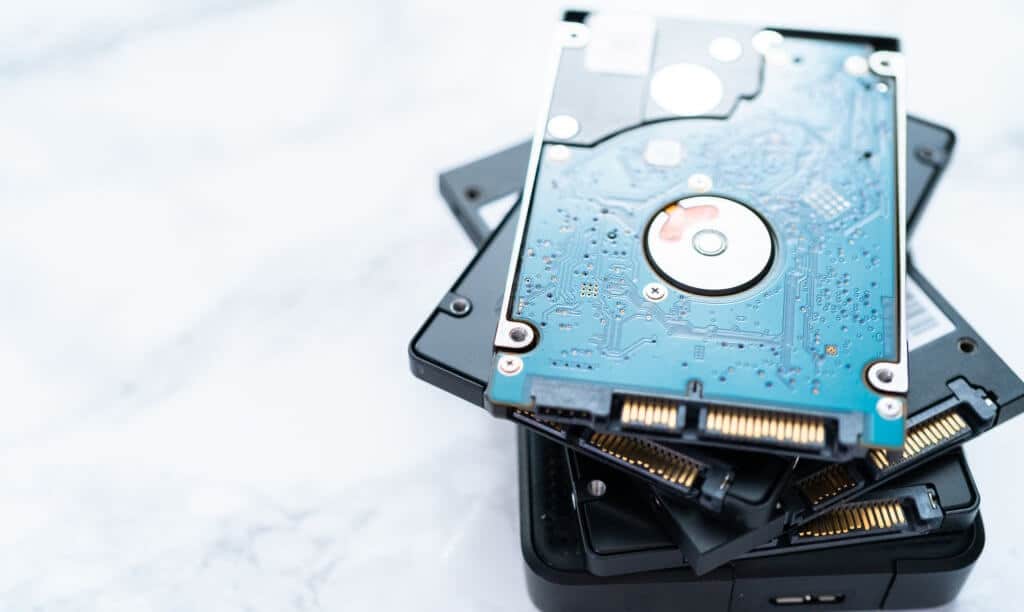Laptops are not cheap and when you want to buy one, you need to consider the amount of storage space you will need. You will seriously regret purchasing a laptop that does not have adequate storage space for your needs. However, storage can be expensive, so expect to pay more if you need a lot of storage.
It is better to invest a little more on storage when you purchase your laptop than have to try to fix the problem afterward. Yes, you can buy an external storage drive, but these are expensive. So follow the advice in this guide and work out what storage space you need right now and in the future.
Table of Contents
How much Storage do I need for my Laptop – No perfect answer
You need to understand that there is no perfect answer for determining the amount of storage you need for your laptop. Both Apple Mac and Windows PC laptops come with different storage options.
If you are interested in purchasing an Apple MacBook Air, for example, you will choose either a 256 GB storage drive or 512 GB of internal storage. Going for the larger internal storage option is going to cost you about $200 more.
With Windows laptops, you can find models that have internal storage starting from 128 GB. Usually, there is a 250 GB option, a 512 GB option and a 1 TB option. The additional storage will not cost as much as it does for a MacBook Air but it still won’t be cheap.
Consider the Operating System and other factors with Internal Storage space
A mistake that many people make when buying a laptop is not to consider the internal storage space that the operating system takes up. If you are considering a 512 GB storage solution for example, there will not be 512 GB available to you to use for your files.
Windows 10 requires around 15 GB of storage and the macOS (High Sierra) takes up over 8 GB of internal storage space. Another thing that you need to know is that 512 GB isn’t really 512 GB. This is because laptop suppliers use base 10 figures rather than binary figures so you always get less than advertised.
There have been many tests conducted on the actual space available. A good example of this was a study that found that each advertised gigabyte of internal storage was over 70 megabytes less than this.
So if you want a Windows 10 laptop with 128 GB of internal storage, subtract about 20 GB for the operating system and then factor in the real amount of storage available. It will reduce 128 GB to around 99 GB. If you apply this to 256 GB it becomes 218 GB and 512 GB becomes 456 GB.
You will use up 128 GB in no time

We do not recommend that you purchase a laptop that has only 128 GB of internal storage. If you are going to use your laptop often you will find that you will use all of the available space very quickly. Videos and images can take up a lot of space and unless you have another storage option available, you can quickly max out your internal storage space.
Every application that you install on your laptop will take up space. For example, most modern browsers will require at least 200 MB of storage space. Graphics applications and video editing will require even more. So trust us when we tell you that you will eat through 128 GB very quickly.
Many laptop manufacturers will not provide a model with only 128 GB of internal storage because they know this is insufficient. Usually, the lower-priced models have a minimum of 250 GB internal storage. Apple is certainly doing this with their latest MacBook Air and MacBook Pro laptops, and several Windows-based laptop providers are doing this as well.
How much Storage Space are you using right now?
Do you have a laptop or desktop computer that you are using right now? If so, this is a good place to start when deciding how much storage space you need with a new laptop. It is easy to check the storage you have used with both a Windows and Mac computer.
If you use a Windows-based computer, click on the Start button and choose the File Explorer. Once this appears, select This PC. Windows computers often have different storage drive partitions so that you may have a C drive and a D drive, for example. You can see how much free space you have for each drive and easily calculate what you have used.
When using a Mac computer, you will need to go to the top left of the screen and click the Apple logo. Then you need to choose About this Mac and after this click on Storage. You will then see a screen that tells you the amount of internal storage you have used.
What do you plan to use your Laptop for?

You may have a different use in mind for your new laptop than you do for your existing computer. For example, suppose you think that you will only use your laptop for business, such as using applications like MS Word and MS Excel for document creation and spreadsheets. In that case, you will probably be OK with 256 GB of internal storage.
In this scenario, 256 GB would also provide enough space for other files such as photographs and files for other applications. If you are in any doubt about this, then go for the larger 512 GB option. Buying a larger drive for your laptop, later on, will cost more and you have the additional hassle of reinstalling the operating system and all of your applications.
Maybe you want to save many videos on your new laptop? You may want to create videos and then edit them on your machine. Having a lot of videos stored locally on your laptop will consume a lot of internal storage. You may find that 256 GB is simply not enough and you will be better off with 512 GB or 1 TB if this option is available.
Using your laptop for graphic design or gaming is where you will need maximum internal storage. We recommend a minimum of 512 GB here. Modern games can take up a minimum of 5 GB each and a single 4K high-resolution image can be 1 GB. If you can afford 1 TB internal storage, then we recommend that you go for this. It will be worth it in the long term.
Should you choose an HDD or SSD drive?

An HDD is a conventional hard disk drive where SSD is a solid-state drive. SSD is a lot faster than HDD, and if you can afford this, we highly recommend it. In addition, your operating system (Windows or Mac) will be faster, and so will your applications.
HDDs have been around for a long time and are reasonably reliable. But they have moving parts and eventually, they are likely to fail due to usage. An SSD will not last forever either, but it will tend to outlast an HDD drive.
These days you can find laptops that have a combination of both SSD and HDD internal storage drives. Your operating system and applications are stored on the SSD drive so that your laptop will run faster. You can use the conventional HDD drive for file storage.
SSD drives are more expensive than conventional HDD drives, so you need to consider this. If you have the budget for an SSD drive, then we would always recommend this. Your laptop will run a lot faster and SSD has no moving parts so it should last longer.
Final Words
It would help if you took the time to think about the amount of internal storage you will need with your new laptop. While it is possible to upgrade your laptop with a higher storage capacity later on, we do not advise this as you will need to reinstall your operating system and applications, which can be very time-consuming.
Therefore, we recommend avoiding a 128 GB internal storage option and going for a minimum of 256 GB. If you know that you will need more space for large photo and video files, choose 512 GB or 1 TB. It is better to have more internal storage space than you need.




Be the first to comment